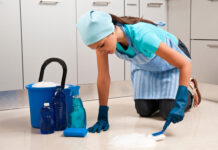You and your spouse have made the decision that you are going to return to work, however, you are not willing to give up the nutritional benefits (or the bond) of breastfeeding your child exclusively. You’re not the first mom to pump while in the workplace, and we know you can do it! Here are some tips on how and where to start.
Materials Needed:
Breast Pump: If you’re going to be working full time, a double electric pump is highly suggested. It will take half the time as a single pump, which will appease your employer and maximize your time working, as opposed to pumping. If you’re in the market for a pump, we suggest this Medela Double Electric Pump. That particular pump has many of the accessories that will be mentioned shortly.
Storage Bottles or Bags: You will need bottles that hook specifically to your pump. If you plan to take your milk home and freeze them, bags are a great option, because they can be frozen flat. Our favorite kind of bags are Lansinoh 8oz storage bags.
Cooler and Ice Pack: You will need a small cooler with an ice pack inside that will keep your milk cold throughout your work day.
Bottle Brush and Dish Soap: Every time you use your pump, you will want to wash out the shields and the valves, as well as washing out the bottles (if you are transferring to the bags to store.) Invest in a bottle brush and some natural dish soap to keep in your pumping bag.
(Optional) Hands-free pumping bra: Pumping hands free is a lifesaver for some women. If you have your own private office, a hands free pumping bra enables you to close the door and blinds and pump while still being able to work on the computer, or do desk work. At home, it allows you to use the phone, or scroll through your favorite Daily Mom posts on your computer, without having to constantly apply pressure to hold the shields in place. It has also been known to help women with “let down” problems, because they can relax easier while pumping.
Tips:
Pumping milk while away from your baby can be tricky for some women. They may have a hard time achieving let down, or may not be pumping as much milk as what their baby is eating during each feeding while away from them. Below are some tips to try during your pumping session if you run into any unforeseen problems.
- Get a head start! Before returning to work, stockpile some frozen bags of milk to give to your daycare provider. An easy way to begin to pump and store is to begin pumping right after your baby’s first feed of the morning. Typically, you have the most milk at that time, and you will be thankful to have those bags of milk in storage in emergency situations that may come up down the road.
- Store different amounts. Do not automatically try to fill up every single bag to its capacity. Your baby may not be at the point where they are drinking that amount. Talk to your daycare provider about breastmilk, and how to handle it safely (such as not microwaving, or how to “defrost” and only heat up minimum amounts and add to the bottle, if the baby wants more.)
- Drink lots of water. Yes, we know it sounds cliche, however, it really does ring true. A pregnant or lactating women should be drinking at least 3 quarts of water daily. Getting that amount of water in you will help you produce more milk.
- Try covering up. Do you know the term, “A watched pot of water will not boil?” Well, sometimes the same thing rings true for pumping milk. If you are obsessing and watching the ounces drip in, drop by drop, you are possibly stressing out more than you normally would. Do you obsess when your baby is latched over how many ounces they are swallowing? No! Just cover up, relax, and trust your body.
- Pictures, or smells, may help. Sometimes, women have been able to induce let-down by looking at photos or videos of their baby, or smelling a garment that carries the sweet baby scent.
- Give it time. Your body will get into the groove of pumping, and you may just have some rough days. Don’t get discouraged and give up! Many women have stated that it took their body one to two weeks before being able to produce a “normal” amount of milk.
- Talk to a lactation consultant regarding herbs. Many women have really benefitted by using milk producing aids with herbs. If you are coming up short with your production, talk to your doctor or L.C. about herbs such as fenugreek or lactation teas that have these herbs in them. Make sure to not automatically start taking these herbs without pumping for a while, as they may cause serious problems such as clogged ducts, or mastitis.
Employee Relations:
Many states (such as California) are really making strides towards women’s rights regarding pumping in the workplace, however, sadly many states do not have such laws protecting a women’s choice to express milk. Talk to your employer before returning to work about your desire to express milk. Find out if there is a quiet place that you will be able to go every few hours. Reassure your supervisor that you will make up for time lost while pumping by using your pumping time as your legal breaks, or coming in a bit earlier to compensate. If you’re able to pump in a closed office, talk to them about your plans of using a hands free device, and how you’re still able to also complete desk work. If all else fails, talk to Human Resources about your legal employee rights.
Being open, and considerate to your employer’s need in a productive staff member is key, as is expressing and stressing that within your conversation with them.
Returning to work is stressful, and there are so many things on your mind as you prepare. Going into pumping with an open mind is important, just as much as it is imperative to have a “can do!” attitude. Your body may need some coercing, but you will adapt, and however you choose to do so, is the perfect solution for you and your baby.
Photo Credit: Cookies for Breakfast








































Love this article!!
I returned to work when my son was 3 months old and have pumped using a Medela pump since. It was tough in the beginning but now that he’s 10 months old and we’ve been working this way for awhile, things are going well. I’m hoping to go until he is at least 18 months old.
I hope loads of women will see this article. Being a full-time working mom and breastfeeding IS possible!!
I returned to work at 7 weeks PP and pumped for a week before I became engorged and developed mastitis. If you can put off returning to work for a longer time than I could – do it! I blame my early return to work for my inability to continue breastfeeding my twins. 🙁
http://nikkieandbabies.blogspot.com
With my first kid, I was in high school still, and tried to pump one time in the nurses office.. it was so awkward, it hurt and I could hear students coming/going and I never tried again.
With my daughter, I went back to work just before 6 mos post partum and continued pumping for 6 months. I went to my employer with an excuse from my doctor to increase my breaks to two 20-min breaks besides my lunch. At first, I just had a private bathroom to pump in. Thankfully it was big and kept clean, I sat on the floor on the side opposite the toilet and tried to keep everything clean. Then I was moved to a office, but it didn’t lock and there was a window. So we threw a table cloth over the door with a “Keep out, Office in Use” sign and all the supervisors knew what I was doing. Regardless, I was still walked in on once. Looking back, I would have requested better space but there really wasn’t anywhere else to go anyways. (it was a big office for customer service)
I used the Medela double pump, the backpack style. I kept an ice pack in the cooler and would pump into bottles. When I got home I’d dump it into a storage bag with the date and ounces written on it and put it in the freezer.
My best advice is to make it a routine and try to relax. I’d put music on my phone if I had trouble, or just close my eyes and put my head back. Make sure your nipples are in correctly or you will get sore. Keep lanolin or extra breast pads in your bag, perhaps an extra shirt as well. One day I didn’t realize I was leaving my chest against my desk until it was soaked down to my stomach. I didn’t have an extra shirt… I emailed my supervisor to bring me the sweater she kept in her desk! That was slightly embarassing but I don’t think any coworkers noticed.. might’ve wondered why I wanted a sweater in mid-summer though haha. I also drank a lot of that tea that’s supposed to help create more milk, I could never tell if it worked though.
Good luck ladies! My kids are 10 and 5 and when I stumbled across this article I actually became nostalgic of those days.
I would encourage any woman in this position to be aware of and fight for her legal right to get a lactation room at work. It’s required by law. I’ve never had a baby but I’m a federal employee and we’ve had to advocate for a lactation room even in our workplace. If you show them the requirements, most employers will not turn you away. Check it out! https://www.dol.gov/whd/nursingmothers/